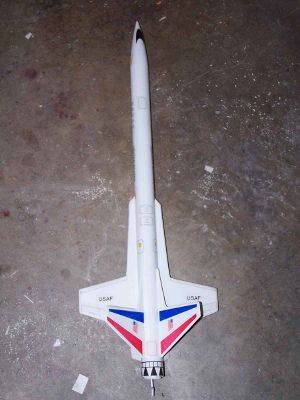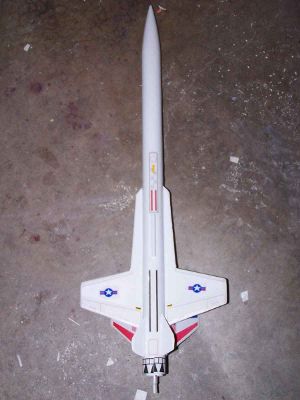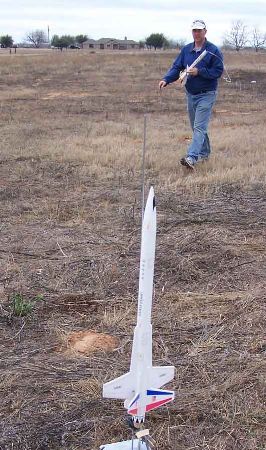| Published: | 2010-11-13 |
| Diameter: | 0.98 inches |
| Length: | 19.25 inches |
| Manufacturer: | Quest  |
| Skill Level: | 3 |
| Style: | Futuristic/Exotic |
The kit came packaged in a long plastic bag with a detailed picture of the kit on the front cover including even an inlay to show the unique fins. (picture from John Coker's Review)
Quest's instructions are fully illustrated and clear. Anyone with some Estes' kits under there belt will have no difficulty with building Quest kits. The Intruder's instruction even illustrated clearly how to tie a knot attaching the Kevlar® and elastic portions of the shock cord together. Clear measurements as to where parts should align and the assembly instructions were in a logical order. Final steps include sealing, painting and decal placement. Lastly, there are guidelines for flying your Intruder™.
![[Cover]](/images/archive/images2/rp_qst_intruder_cover.jpg) The kit uses a single 0.984" body tube, plastic nose cone which needs to be assembled, a
motor mount assembly including motor clip, one 12" Tuff-Chute™(plastic) parachute with shroud lines and
gripper tabs, a balsa wood sheet with the 10 die-cut pieces that ultimately make up the six fins, a piece of Kevlar®
and a piece of elastic to make up the shock cord. Lastly a decal sheet with nearly 40 decals.
The kit uses a single 0.984" body tube, plastic nose cone which needs to be assembled, a
motor mount assembly including motor clip, one 12" Tuff-Chute™(plastic) parachute with shroud lines and
gripper tabs, a balsa wood sheet with the 10 die-cut pieces that ultimately make up the six fins, a piece of Kevlar®
and a piece of elastic to make up the shock cord. Lastly a decal sheet with nearly 40 decals.
I used Quick Grab glue on this model (additional comments about Quick Grab glue) for everything except gluing the fin pieces together where I used yellow wood glue.
The challenging part of this kit is the assembly of the fins. Both the Tail Fins and the Wings consist of two pieces of balsa that need to be glued together. To do this, the instructions suggest using a piece of wax paper on a flat surface and aligning the two pieces with a straight edge. There was some sanding required to get a good fit of the two pieces. Take your time. Once the Tail Fins and Wings are assembled, then assembly is straight forward.
There is an interesting tip in Step 8 of the instructions. The nose cone is inserted into the bottom of the body tube, tip first, and while rotated is pressed inward. This is to slightly stretch the body tube for ease of sliding in the motor mount. The same technique is used in Step 2 for the motor mount centering rings.
One of the ways that Quest kits differentiate themselves from Estes is in the shock cord mount and material. Everyone is familiar with the ol' three-fold, flat elastic method used by Estes (and Custom) which is glued near the top of the nose cone. Quest uses a piece of Kevlar® attached to the motor mount and tied to a piece of round elastic. Overall, the performance seems to be better.
I followed my normal finishing techniques using primer, sanding, primer, sanding, primer, sanding and then painting a gloss white. I then placed the decals I wanted onto the rocket. These decals are peel and stick, however, the instructions indicate that after peeled, they should be dipped in warm water that has a drop of dish soap. This technique helps in positioning the decals before they stick.
Overall, for CONSTRUCTION I would rate this kit 5 points.
The flight of the Intruder™ is what has me baffled. The recommended motors are Quest A6-4, B6-4, C6-5, and C6-7. I first tried it on an A8-3.
The flight actually fluttered around for a second or two and certainly didn't seem stable. Well, I had an opportunity to fly it again (although I hadn't changed anything) so I did on a B6-4. This went up, however it seemed as if the tail was waving to us the whole way. I tried to fly her one more time on a C6-5 and to my amazement she flew off the rod as straight and high as one could expect.
I decided to add some nose weight, but I'm still not sure if that was the right thing to do. The next A8-3 flight was straight giving me a sense of confidence that adding the nose weight was a good idea. Then I went to a B6-4 and again, this bird waved its tail at us the whole way up. I flew her again on a C6-5 and an excellent flight was observed. I figured something could have been wrong with the B6-4 motor, so I repeated it. And again, a wavy tail!
This one has be confused. I have been looking through the stability chapters of Harry Stine's book but just can't get it.
The Quest parachute has performed well on all the flights, never losing a shroud line. This parachute does seem to perform better than an Estes' parachute with the only disadvantage being the size of the shroud line Gripper Tabs. These are tough, but don't flex at all, therefore you have to be conscious of this when folding your parachute. I put my tabs facing up in the body.
No signs of burning or stress on the Kevlar®
shock cord and the parachutes both opened cleanly.
For FLIGHT/RECOVERY, I would rate this kit 3 1/2
points.
Overall, for the looks I believe the Intruder™ is a nice kit, however, the flight characteristics concern me. Of course it could be just this particular rocket or could to it be the glue (see Rogue's Hex Courier review). I give the kit an OVERALL rating of 4 points.
(Contributed - by John Coker)
![[Rocket Pic]](/images/archive/images2/rp_qst_intruder.jpg) The Quest Intruder(TM) kit
was the first model rocket I completed. What was available at my local hobby shop was Estes and Quest kits (and not too
different ones). I bought this kit and the Estes Black Brant II kits as my first foray back into model rocketry and
being a B.A.R. Although building kits probably doesn't get me any coolness points as an adult model rocketeer, they
were fun to build and good way to get back into the hobby.
The Quest Intruder(TM) kit
was the first model rocket I completed. What was available at my local hobby shop was Estes and Quest kits (and not too
different ones). I bought this kit and the Estes Black Brant II kits as my first foray back into model rocketry and
being a B.A.R. Although building kits probably doesn't get me any coolness points as an adult model rocketeer, they
were fun to build and good way to get back into the hobby.
The Intruder is a rocket of no particular scale: "Futuristic interceptor patrols the outposts of interplanetary space." This is Quest kit #3001. Kit information and a full-size picture of the front of the package is here. This was a good kit and I enjoyed building it. I particularly like the way Quest sets up the shock cord (Kevlar® thread to the motor mount).
One thing I didn't like much about this kit is the thickness of the decals. I'm reluctant to call them decals (even though they worked that way), they're more lick stickers: thick and immune to decal set. On the phone below right you can see the shiny backing reflecting sunlight. There were lots of decals, representing some sort of futuristic military transport (I guess) so I guess they were worried about them tearing.
The Intruder had an cool looking cover at least compared to the other Estes and Quest kits available at my local hobby store. Also, it was one of the few without pre-formed plastic fins which would take away all the fun. In the end, it came out looking very good (my version).
Estimated Maximum Altitude: 800 feet
Recommended Rocket Motors: A6-4 (first flight), A8-3, B6-4, C6-5, C6-7
Length: 19.25" (48.9 cm)
Body Diameter: .984" (25 mm)
Weight: 1.3 oz. (37 g)
![[Close Up]](/images/archive/images2/rp_qst_intruder02.jpg)

(Contributed - by John Lee - 02/15/09)
Brief:
The Intruder seems to have been Quest's version of the Estes Interceptor. It's not a clone but the physical
resemblance is definitely present. Although the styling is like that of Estes, the rocket itself displays a distinct
Quest flavor. I had not built a Quest kit in quite some time and this one reminded me of the reasons I liked the ones I
did build.


Construction:
Construction begins with the plastic nose cone. The base must be glued to the body using tube type plastic cement. I
found that the plastic seemed heavier than that of of similar Estes cones. There was almost no flash to trim and it
seemed sturdy.
The motor mount comes next. A slit is made for the engine hook and then the first centering ring is glued in place. I used yellow glue. A piece of Kevlar® is then knotted and run through the other centering ring which is then slid into place. Yellow glue was used to fillet both rings and a piece of elastic was tied onto the end of the Kevlar® and secured with a drop of glue. A thrust ring mounted right above the top of the engine hook completes the motor mount assembly.
When the motor mount had a night to dry, it was test fit into the BT and found to be just right without any sanding needed. A ring of yellow glue was applied to the interior of the tube and the mount was shoved in so that the actual motor tube was even with the aft end of the BT.
The kit comes with a wraparound alignment guide on the first page of the instructions. The guide was cut out and wrapped around the BT. I oriented it so that the launch lug line aligned with the engine hook and secured it with a piece of tape. The various lines were then transferred to the BT and elongated along a door edge.
The fins came in a die-cut balsa sheet. They were freed from their captivity by the judicious use of a hobby knife. The resulting edges were a bit rough but similar pieces were stacked and had their edges sanded.
The tail fins and main wings are both built up out of two pieces each. They were laid out flat on a piece of wax paper and CA was used to glue the pieces together. A metal ruler was used to ensure alignment. The tail fins fit together fine but the main wings did not. The angles did not precises match up so that there is a bit of a gap on the top part of the intersection. These gaps were filled with Elmer's Wood Filler when the time came.
A sanding block was used to bevel the edges of all the fins except for the root edges. It was while doing this that I noticed how brittle the balsa was and how it had a habit of chipping and flaking. I also noticed that the front extension of one of the tail fins was longer than the other one. I resolved to cut the longer one back to match the shorter when I got through sanding.
Instead, I promptly forgot about the longer extension and went on to apply Elmer's Wood Filler. I brushed it on and scraped off the excess with a razor blade and set them aside to dry. When dry, I sanded down with #400 sandpaper.
The fins were applied to the BT with yellow glue and a double glue joint. This worked well until I noticed the longer extension of one of the tail fins and remembered that I had forgotten my resolution. I also found that one of the wings would not sit flat against the BT. I let the base of the wing dry and then applied a bit more glue to the forward end and taped it down to dry.
When the fins were dry, the process of filleting began. This was a long process on this rocket and it would have been helped immensely by the possession of skinnier fingers but eventually it was done.
While doing the filleting, I noticed a lonesome pencil line and realized that I had again forgotten the launch lug. It was glued on 5" from the aft end.
Finishing:
The rocket was primed with Kilz. A total of 2 coats were applied. The Kilz was then sanded down after a day of drying
and the rocket was sprayed with gloss white. Two coats gave good coverage.
Probably the biggest disappointment of this project was the decals. There were none. The instruction are explicit in describing how to apply waterslide decals. They say absolutely nothing about peel off stickers. That's right, instead of decals, I got stickers. The only resemblance to decals was that they did need to be cut out since all were on a single sheet.
The instructions say to use the face card as a guide and also give a dorsal and ventral view in black and white...and too small to be of much use.
I must admit that for stickers, the quality was not too bad but I really wish they had been decals.
My first decal session got me about halfway through. They cut well and I managed to get pretty close to the edges. I did have a problem with static charge though. As I would get the sticker close to the body, an electric charge effect would either pull it down where I did not want it or push it away. Fortunately, these were forgiving as to peeling and re-sticking.
The second decal session went quite a bit quicker than the first. Mostly, it consisted of applying hatches, lettering, and such. While working on them, I noticed something else about the stickers: they do not match up exactly to what is shown on the face card. Where I noticed differences, it was a matter of the sticker being much less detailed and complex than the analogous decal on the face card. Also, there were a few symbols that did not appear at all on the sticker sheet.
The gloss from the stickers really stands out. I hoped that a coating of Future Floor Polish will even things out when I get done. I wound up putting on 2 coats of Future. It helped but the fact that the rocket is covered in thick stickers is still obvious.
PROs: Simple white scheme is very effective with "decals".
CONs: The decals are not decals but stickers instead.
Construction Rating: 3 out of 5

Flight and Recovery:
The maiden flight of the Intruder took place on a very windy day. It was prepped with a 9" nylon chute and a
Quest A6-4 motor.
The countdown went smoothly but things seemed to be less than spectacular after that. The rocket got to the end of the rod just fine but seemed to struggle into the air after that. It did a small amount of corkscrewing, ejected, and came back to earth with no real problem or damage. It just seemed very ungainly throughout. A video of the first flight can be seen here.
For the second flight, I upgraded the power to an Estes B6-4. It flew much better and higher, but the corkscrewing was even more pronounced. A video of the second flight can be seen here.
Flight Rating: 3 out of 5
Summary:
I have to accept some of the blame for the flight performance myself. I cannot guarantee that I got everything
straight and perfect. I think this is a nice model. I just did not do it justice.
Overall Rating: 3 out of 5
 |
 |
Flights
 |
 |
B.E. (May 1, 2001)
J.B.S. (August 27, 2003)
W.C. (December 4, 2003)
B.A. (March 23, 2006)
D.R. (November 4, 2006)
F.S.W. (February 22, 2009)
Sponsored Ads
 |
 |












S.J. (April 1, 2000)